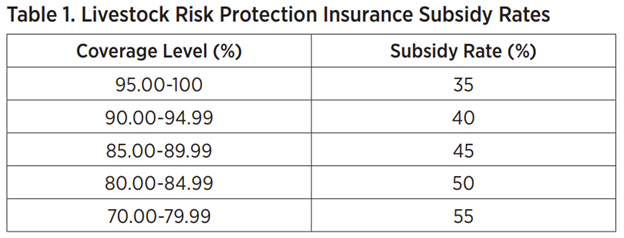Specialist Advice: Bagley Risk Management Methods
Comprehending Animals Threat Defense (LRP) Insurance: A Comprehensive Overview
Navigating the world of livestock threat security (LRP) insurance policy can be an intricate undertaking for many in the agricultural field. From how LRP insurance coverage functions to the various insurance coverage choices readily available, there is much to uncover in this comprehensive overview that might potentially shape the means livestock manufacturers come close to threat administration in their services.

Just How LRP Insurance Coverage Functions
Sometimes, recognizing the mechanics of Livestock Danger Security (LRP) insurance policy can be complicated, however breaking down how it functions can give clarity for farmers and breeders. LRP insurance is a danger administration device developed to secure livestock producers against unanticipated price decreases. The plan allows manufacturers to establish a coverage level based on their details demands, selecting the variety of head, weight range, and protection rate. Once the plan is in place, if market rates fall listed below the protection rate, producers can sue for the difference. It's important to note that LRP insurance coverage is not a revenue assurance; instead, it focuses entirely on rate threat protection. The coverage period commonly varies from 13 to 52 weeks, providing adaptability for producers to choose a period that lines up with their manufacturing cycle. By using LRP insurance coverage, ranchers and farmers can minimize the economic dangers connected with varying market rates, ensuring higher security in their procedures.
Qualification and Protection Options

When it comes to insurance coverage choices, LRP insurance offers manufacturers the versatility to pick the insurance coverage degree, coverage duration, and endorsements that best fit their risk monitoring requirements. By understanding the qualification standards and coverage options readily available, livestock manufacturers can make educated choices to handle risk efficiently.
Pros and Cons of LRP Insurance Coverage
When examining Animals Threat Protection (LRP) insurance, it is necessary for animals manufacturers to evaluate the disadvantages and benefits inherent in this danger monitoring tool.

One of the key benefits of LRP insurance coverage is its capacity to give defense against a decrease in animals prices. Additionally, LRP insurance coverage uses a level of adaptability, permitting producers to personalize protection levels and policy periods to match their certain demands.
Nonetheless, there are likewise some drawbacks to take into consideration. One limitation of LRP insurance policy is that it does not secure versus all kinds of threats, such as illness outbreaks or natural disasters. Additionally, premiums can sometimes be pricey, especially for manufacturers with large animals herds. It is important for manufacturers to very carefully examine their individual danger direct exposure and economic circumstance to establish if LRP insurance is the ideal risk monitoring device for their operation.
Understanding LRP Insurance Coverage Premiums

Tips for Taking Full Advantage Of LRP Perks
Taking full advantage of the benefits of Animals Risk Security (LRP) insurance coverage requires strategic planning and proactive danger management - Bagley Risk Management. To maximize your LRP protection, consider the complying with pointers:
Consistently Examine Market Conditions: Keep informed concerning market fads discover this info here and price fluctuations in the animals industry. By checking these aspects, you can make educated choices about when to purchase LRP protection to protect against possible losses.
Set Realistic Coverage Levels: When picking coverage degrees, consider your production prices, market worth of livestock, and prospective dangers - Bagley Risk Management. Establishing sensible insurance coverage degrees guarantees that you are adequately shielded without overpaying for unneeded insurance policy
Diversify Your Coverage: Rather of depending solely on LRP insurance coverage, take into consideration expanding your danger management approaches. Incorporating LRP with other danger administration devices such as futures contracts or alternatives can offer detailed insurance coverage against market uncertainties.
Evaluation and Adjust Protection Consistently: As market problems transform, occasionally assess your LRP insurance coverage to guarantee it lines up with your existing threat direct exposure. Adjusting insurance coverage levels and timing of purchases can help enhance your risk security approach. By adhering to these ideas, you can make best use of the advantages of LRP insurance and protect your livestock procedure versus unanticipated risks.
Conclusion
To conclude, animals danger protection (LRP) insurance coverage is an important tool for farmers to take care of the economic dangers related to their livestock operations. By understanding just how LRP functions, eligibility and protection options, in addition to the benefits and drawbacks of this insurance coverage, farmers can make informed choices to shield their resources. By thoroughly considering LRP costs and applying approaches to make best use of advantages, farmers can minimize potential losses and make certain the sustainability of their operations.
Livestock manufacturers interested in acquiring Animals Threat Security (LRP) insurance can explore an array of eligibility criteria and coverage options tailored to their particular animals operations.When it comes to coverage choices, LRP insurance policy uses manufacturers the adaptability to pick the insurance coverage level, protection duration, and endorsements that finest suit their risk management requirements.To grasp the ins and outs of Animals Danger Defense (LRP) insurance coverage totally, comprehending the variables influencing LRP insurance policy premiums is important. LRP insurance coverage costs are figured out by different components, consisting of the coverage degree selected, the anticipated cost of animals at check it out the end of the insurance coverage duration, the kind of livestock being guaranteed, and the size of the protection period.Review and Readjust Insurance Coverage Frequently: As market problems change, periodically evaluate your LRP insurance coverage look at here to guarantee it aligns with your existing risk direct exposure.